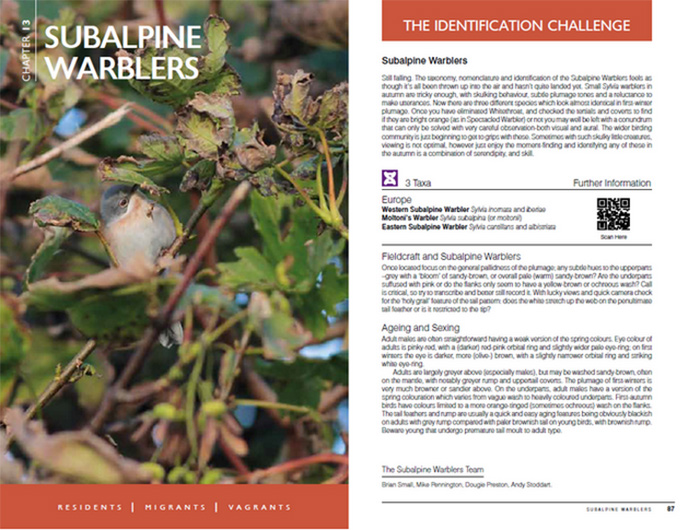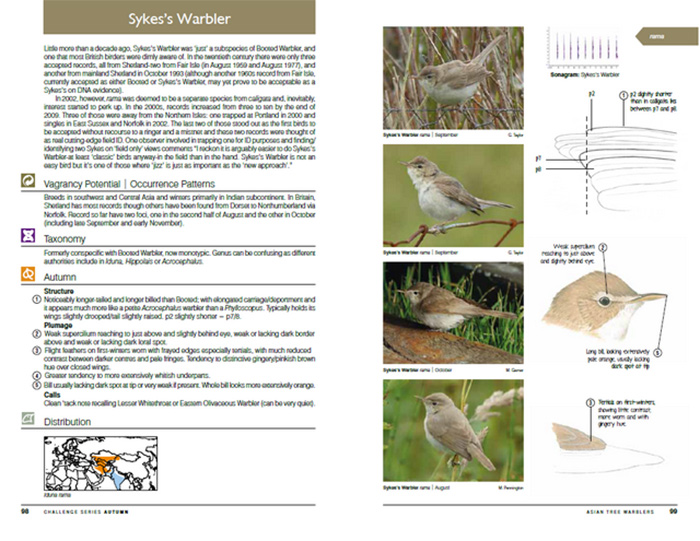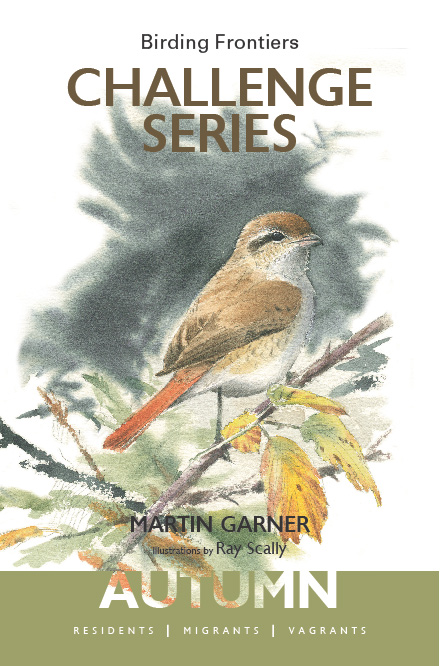Birding Frontiers Challenge Series: Autumn
Martin Garner
Martin Garner is well known for his Birding Frontiers website and his 2008 book ‘Frontiers in Birding’. Obvious in both is an infectious enthusiasm, a real delight in birds, a love of discovering and learning and a real ability to collaborate and communicate. These attributes are now showcased once more in Martin’s latest book. The first in what will presumably be a series, it focuses on a range of cutting edge identification topics which might be encountered in Britain in autumn.
To quote Donald Rumsfeld, these range from the ‘known unknowns’ to the ’unknown unknowns’. In the former category are the long-standing problems of Northern Harriers, Wilson’s Snipes, South Polar Skuas, Pallid Swifts, Isabelline Shrikes, Taiga Flycatchers, Lesser Whitethroats, unstreaked Acrocephalus warblers, Stonechats, Siberian Chiffchaffs, Subalpine Warblers, Booted and Sykes’s Warblers and Northern Treecreepers and Great Spotted Woodpeckers whilst in the latter are a range of topics which will be ‘off radar’ for most - potential vagrant accipiters, Steppe Buzzards, Cabot’s Terns and Yellow-streaked Warblers.
As might be expected, the text treatments are lively and ‘chatty’, the introductory sections drawing heavily on the power of story, often a personal anecdote or shared experience, to inspire reader involvement. Then, for each species group, come brief sections on fieldcraft (how to maximise the viewing opportunities) and ageing and sexing before further paragraphs for each form on vagrancy potential/occurrence patterns, taxonomy, an identification ‘bullet point’ summary and a distribution map.
None of this is at all ‘dry’ or ‘stodgy’. Though some of the content is highly complex, the texts summarise the subject matter well and the uncertainties are adroitly handled. A nice touch is the inclusion within each section of a line featuring ‘the team’, an acknowledgement that pushing the boundaries of our knowledge is very much a shared experience.
Just like ‘Frontiers in Birding’, the treatments are not re-hashes of currently-understood identification criteria. Instead, they explore the boundaries of our knowledge, testing and questioning our conventional wisdom and asking new and often teasing questions.
Even in the ‘known unknowns’ there are many unresolved issues, indeed it sometimes seems that we are going as much backwards as forwards. Classic examples of this phenomenon are the current debates over what constitutes an ‘acceptable’ tristis Chiffchaff (and new questions over the British status of abietinus ), the proposed new taxonomy for Subalpine Warblers, the continuing uncertainties around Isabelline Shrikes, the collective confidence, then crisis and now renewed confidence in our late autumn Pallid Swifts and the ‘resurrection’ of ‘lost’ forms such as blythi Lesser Whitethroat and stejnegeri Siberian Stonechat, both of which we were happily identifying twenty-five years ago until they entered a dark period of taxonomic denial. Now that they have re-emerged blinking into the daylight we need to engage with them once more, and this book will help you to do just that.

Amongst the ‘unknown unknowns’ lie even more questions. Could Japanese Sparrowhawk and Yellow-streaked Warbler really reach western Europe? If so, how will we ever know if no-one looks (and I bet no-one does)? Such species may or may not be viable bird-finding targets but their inclusion makes a wider point. We are all guilty of only seeing what we know about and what we expect to see. Looking hard and innocently at what we see, not accepting received wisdom and asking our own questions are at the heart of what this book is about.
Following each of the species texts comes a series of photographs, all well selected to illustrate the identification content and all carefully aged, sexed and dated so as to maximise their usefulness. Further clarification is provided by diagramatic paintings by Ray Scally and, where appropriate, by sonagrams.
‘Frontiers in Birding’ suffered from monochrome dullness, lacklustre design and woeful production quality but this new volume is a huge improvement with a bright, clear, accessible and attractive layout and good use of photographs (including some lovely full-page images) and artwork. The input of a professional designer has clearly paid off.

Some of this book’s content will raise eyebrows and, in the often political world of birding, some of it will prove controversial. Martin though would be the first to agree that this book is unlikely to be the last word on any of its subjects. Furthermore, being so rooted in the experiences and debates of today, it will also date quite rapidly. Much of it will require revision as our knowledge continues to advance but this is of course the essence of the ‘Challenge’ approach. It is also a good excuse for bringing out a future new edition!
Here then is a refreshingly enthusiastic attempt to energise our autumn birding, a call to get out more, to get more value from what we see and to join a collective process of exploration and discovery. At the beginning of the year’s best bird-hunting season, what could be more inspiring than that?
Martin will be launching the book at Birdfair, 15-17 August where it will be available for the special price of £14.99
Alternatively you can purchase it now on Martin's Birding Frontiers website
Andy Stoddart
August 2014







